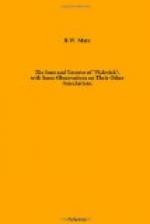This is not unusual, and even in these days we find that Dickens’s characters have become so real that no one stops to discuss whether this or that really happened to them, but just simply accepts their comings and goings as the comings and goings of the heroes and heroines of history are accepted, with perhaps just a little more belief in them. And so we can be assured that the “Angel” at Bury will be chiefly remembered as the hotel where Mr. Pickwick and his companions stayed, whoever before or since may have honoured it with a visit, or whatever else in its history may be recalled as important.
In 1861 Dickens again visited the town to give his famous readings from his works, and put up at the “Angel,” so that the county hotel has many reasons for the proud title of being a Dickensian inn.
CHAPTER IX
The “Black boy,” Chelmsford,
the “Magpie and stump,”
And the “Bull,” Whitechapel
After Mr. Pickwick and Sam had been so cleverly outwitted by Jingle and Job Trotter at Bury, they returned to London. Taking liquid refreshment one day afterwards in a city hostelry they chanced upon the elder Weller, who, in the course of conversation, revealed the fact that, whilst “working” an Ipswich coach, he had taken up Jingle and Job Trotter at the “Black Boy” at Chelmsford: “I took ’em up,” he emphasised, “right through to Ipswich, where the manservant—him in the mulberries—told me they was a-going to put up for a long time.” Mr. Pickwick decided to follow them, and started, as will be seen presently, from the Bull Inn, Whitechapel, for that town.
The reference to the “Black Boy” is but a passing one, and it is not even recorded that Mr. Pickwick stopped there on his journey out; but the inn where Jingle was “taken up” was then one of the best known on the Essex road, and was not demolished until 1857, when it was replaced by a modern public-house which still displays the old signboard. In an article in The Dickensian* Mr. G. 0. Rickwood gives some interesting particulars concerning its history, from which we gather that originally the “Black Boy” was the town house of the de Veres, the famous Earls of Oxford, whose principal seat, Hedingham Castle, was within a short distance of Chelmsford. It was converted into a hostelry in the middle of the seventeenth century, and was first known as the Crown or New Inn. It was an ancient timber structure house, and some of the carved woodwork, with the well-known device of the boar’s head taken from one of the rooms of the old inn, is still preserved in Chelmsford Museum.
[* 1917, p.214.]
At the close of the eighteenth century the “Black Boy” was recognised as the leading hostelry of the town, and was known far and wide. In the Pickwickian days it was a busy posting-house for the coaches from London to many parts of Norfolk.




